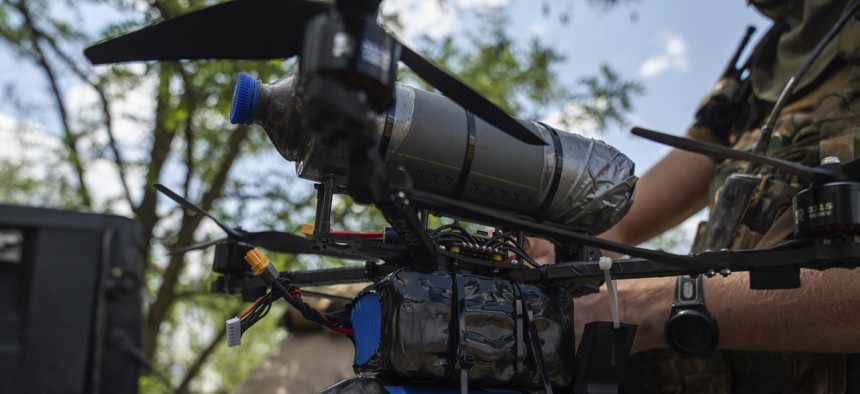
Treat small drones like ammunition, not airplanes, the defense secretary told the Pentagon in a Thursday memo that just might boost production where many other efforts have failed.
“There’s a chance for this to go really fast,” said Allan Evans, CEO of Unusual Machines, a company that manufactures drone parts.
The memo from Defense Secretary Pete Hegseth, which builds on a July 6 White House executive order, does a couple of key things. Most importantly, it directs the Defense Department to treat small drones under 55 pounds—the so-called Group 1 and 2 drones—as consumables rather than “durable property.”
Small drones already don’t have to fit STANAG 4586—the NATO standard that makes sure different militaries can talk to the same drone over the same control link. The memo explicitly removes that requirement; there had been some confusion, particularly in training documents. It instructs U.S. military buyers to not hold cheap battlefield drones to the same interoperability rules designed for larger, more expensive systems.
That will codify that those drones will now be treated like “a munition,” which makes sense when thousands of them are consumed every week on Ukrainian battlefields.
“Drones are the biggest battlefield innovation in a generation, accounting for most of this year’s casualties in Ukraine,” Hegseth wrote in the memo.
The new policy also greatly opens up who in the Defense Department can buy drones, as well as how they can buy them by “delegating authorities to procure and operate drones from the bureaucracy to our warfighters” specifically by colonels and Navy captains at the brigade level. That should create the demand signal that will foster investments by U.S. dronemakers in innovation and production capacity.
The memo also directs the services to treat drones like a resourced capability at the service level. That will allow the services to deploy congressionally allocated budgets to buy drones far more quickly, rather than trying to fund lots of relatively small programs of record. That, in turn, allows purchasers to get around micro-purchase caps for GSA funds (around $10,000). And it will make drone purchases less vulnerable to tardy budgets.
“So now customers could come to our online store and buy $20,000 worth of stuff and just do a [Government Purchase Card], rather than having to find a contract vehicle and justify a contract vehicle and getting the authority to operate,” said Evans.
He likened it to having a dedicated travel budget for the year for work trips, a budget that could be used for any assignment, as opposed to having to get specific approvals for every potential work trip, laying out reasons, expenses, etc.
But some big, more practical obstacles remain to quickly building up U.S. capacity to build lots of drones. The White House executive order took aim at those, directing the Commerce Department to “secure the United States drone supply chain against foreign control or exploitation,” and the Federal Acquisition Security Council to publish a list of “covered” entities, as in Chinese parts suppliers, that should be backlisted from DOD drone acquisition.
Evans said that companies like his, which sources drone parts from the United States (or at least from sources the government deems safe) are already seeing interest from investors.
“We’re in the middle of building out a motor factory. We’ve already priced orders for magnets from some of the few non-Chinese suppliers that are out there…People are gambling that our approach–and that this market–will materialize,” he said. “The industry will react to orders.”
The White House order also lifts some export restrictions for U.S. drone makers, which could be critical for smaller industry players. But, said Evans, the current confusion around tariffs is dampening foreign interest in U.S. drones.
Still, he says, for various reasons, countries in Europe that are now increasing their defense spending, will likely want to build more of their own drones rather than buy them from the U.S. makers.
The post Drones are now bullets: How a new Pentagon policy may accelerate robot warfare appeared first on Defense One.



